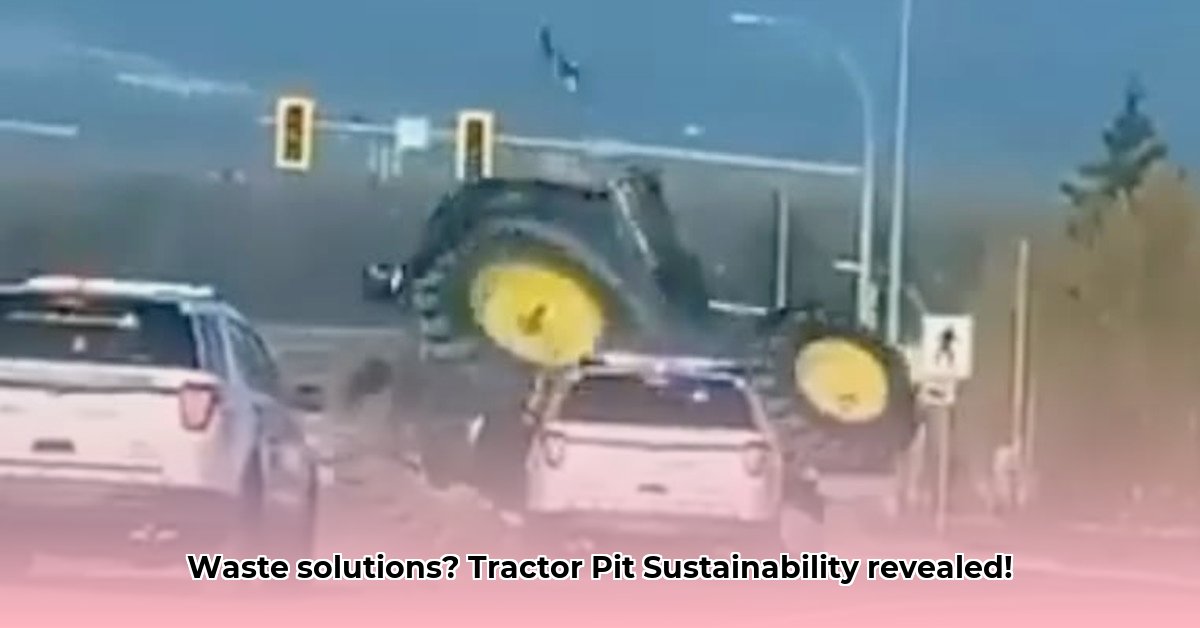
Tractor Pits: Unexpected Heroes of Sustainable Farming?
The humble fire pit, often seen at Tractor Supply and informally called a "tractor pit," might hold a surprising key to more sustainable farming practices. While seemingly unconnected, their potential role in agricultural waste management deserves serious consideration. The very fact that these pits are sold at agricultural supply stores suggests farmers are already creatively exploring their uses beyond simple leisure. Could this readily accessible resource offer innovative solutions to long-standing agricultural challenges?
Burning Questions About Agricultural Waste
One intriguing possibility lies in using tractor pits for the controlled burning of agricultural waste. Instead of contributing to overflowing landfills, leftover crops and organic matter could be responsibly incinerated, significantly reducing waste volume. This presents a compelling pathway toward more environmentally friendly farming. However, crucial questions remain. What's the precise impact on air quality? How efficient is this incineration method compared to other waste-management strategies? Further research is undeniably vital.
Could this simple, inexpensive solution be the start of a revolution in sustainable farming? The potential benefits extend beyond mere waste reduction.
Beyond Waste Management: Energy and Community Benefits
The advantages extend beyond waste reduction. Tractor pits could provide a localized source of heat or even a cooking solution, lowering reliance on fossil fuels, especially beneficial in rural areas. Imagine a readily available, sustainable energy source right on your farm!
Furthermore, a tractor pit can foster a sense of community. It can serve as a gathering place for farmers to share ideas, experiences, and support each other, strengthening rural social bonds and collective knowledge. This social aspect is an often overlooked benefit of potentially simple solutions.
A Collaborative Effort: Turning the Idea into Reality
Realizing the potential of tractor pits in sustainable agriculture requires a collaborative approach involving farmers, Tractor Supply Co., researchers, and policymakers.
Actionable Steps:
For Farmers:
- Explore safe waste burning: Research and implement safe methods for burning agricultural waste in tractor pits, prioritizing air quality.
- Conduct practical experiments: Test the efficiency and practicality of using your tractor pit for controlled burning, recording observations.
- Share your findings: Network with fellow farmers to share experiences and foster collective learning.
For Tractor Supply Co.:
- Assess market demand: Investigate the potential market for specialized fire pits designed for safe and efficient agricultural waste incineration.
- Develop innovative designs: Design eco-friendly fire pits optimized for safe and efficient waste burning, using sustainable materials.
- Educate farmers on proper use: Provide clear information and guidance on the safe and effective use of these specialized fire pits.
For Researchers:
- Evaluate environmental impact: Conduct rigorous studies to assess the environmental impact of tractor pit incineration on air and soil quality.
- Benchmark against existing solutions: Compare the efficiency and sustainability of this method against established agricultural waste-management solutions.
- Improve pit design: Research and develop improvements in fire pit design to boost efficiency and minimize emissions.
For Policymakers:
- Review existing regulations: Update local and national regulations to legally permit responsible burning of agricultural waste in designated areas.
- Offer financial incentives: Establish programs or grants to incentivize farmers to adopt sustainable practices, including tractor pit incineration.
- Fund further research: Allocate funds to support research and development efforts for improved tractor pit technology and sustainable practices.
How to Use Fire Pits for Sustainable Agricultural Waste Management
Farm waste presents a persistent environmental challenge, yet a surprisingly simple solution might lie in repurposing readily available resources. This section focuses on the construction and use of fire pits, particularly those built from recycled materials, for sustainable agricultural waste management.
Repurposing and Fire Pit Construction: A Sustainable Approach
Building fire pits from repurposed materials, such as old tractor parts, offers a cost-effective and environmentally conscious approach. This not only reduces waste but can also save considerable money (often less than $100).
Key Considerations:
- Repurposing waste materials significantly reduces material costs and landfill contributions.
- Careful fire pit design minimizes the environmental impact, even with wood burning.
- Propane fire pits offer controllable burning but require consideration of propane's lifecycle impact.
- Sustainable wood sourcing and efficient burning techniques are crucial to minimize air pollution.
- Always adhere to local fire safety regulations when building or using fire pits.
Propane vs. Wood: Fueling the Fire Sustainably
While propane fire pits provide cleaner, more controlled burning, the environmental impact of propane production must be carefully weighed. A comprehensive life-cycle assessment comparing propane to sustainably sourced wood is necessary for a complete evaluation.
Wood-burning fire pits, if fueled by sustainably harvested wood and operated with efficient burning techniques, can minimize environmental impact and provide a traditional, cost-effective approach.
Safety First: Minimizing Risks
Regardless of the fuel chosen, safety is paramount. Always comply with local fire safety regulations. Maintain sufficient clearance from flammable materials, ensure proper ventilation, and have a fire extinguisher readily available. Regular maintenance is crucial for both propane and wood-burning fire pits.
Next Steps: A Path to Sustainable Practices
The path to greater sustainability in agriculture requires collective effort:
- Farmers: Experiment with sustainable fire pit designs and fuel choices, documenting results.
- Suppliers: Provide accessible and sustainable materials for fire pit construction, promoting reuse.
- Policymakers: Implement incentives for sustainable practices, including enhanced environmental impact assessments.
The potential of tractor pits in sustainable agriculture remains largely unexplored. However, with collaborative efforts and further research, this simple solution could contribute significantly to a greener, more sustainable farming future.